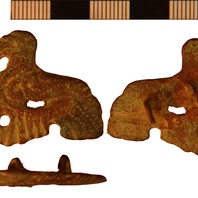
Viking Objects
Viking Bird Brooch (NLM-612074)
This brooch is classified as Weetch’s type 30.C and is decorated with an openwork design representing a bird in profile. For more information on Scandinavian jewellery in England check out our blog: Brooches, Pendants and Pins: Scandinavian Dress Accessories in England.
Read More
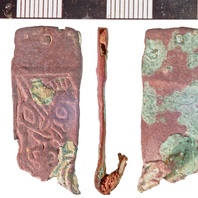
Viking Objects
Borre-Style Strap-End (NLM-F4E3D9)
This strap-end is classified as a Thomas Class E type 4 with Borre-style decoration. Strap-ends came in various styles and were fairly common throughout the Viking world. They were used to decorate the ends of belts and to stop them getting damaged.
Read More
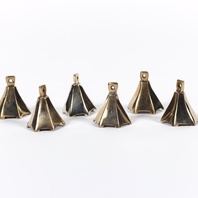
Viking Objects
Reproduction Norse Bells
Bells of this type are described as a ‘Norse’ bell because of their association with Scandinavian sites though not much else is known about their purpose or origin. However, it seems likely that they were used as harness decorations.
Read More
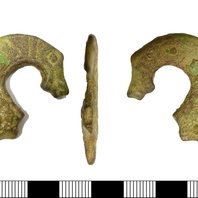
Viking Objects
Copper-Alloy Bridle Bit (LEIC-069A75)
This cast copper-alloy bridle bit fragment is made up of a flat curved section which terminates in a sub-rectangular beast’s stylised head above a ‘trefoil’-shaped projection decorated with an incised spiral motif.
Read More
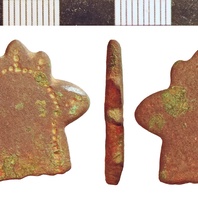
Viking Objects
Bridle Bit (NLM-4CB914)
This bridle bit plate is decorated with rounded protrusions from its edges, apparently representing the head of a beast combining attributes of horse and dragon. The reddish tint of the metal is a common feature of Anglo-Scandinavian metalwork.
Read More
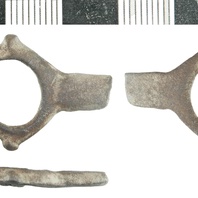
Viking Objects
Harness Fitting (NLM-0C6D7D)
This copper-alloy harness-link fragment consists of a rhomboid loop and the stub of a lentoid section bar. The metal has a reddish tint often associated with Anglo-Scandinavian material.
Read More
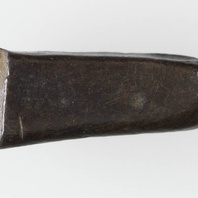
Viking Objects
Silver Ingot (CM.1789-2008)
This silver ingot was made by melting down worked silver cast into a rod and cut into sections. The Vikings arriving in England had a bullion economy where they paid for goods with silver that was weighed to an amount agreed between the buyer and the seller. Hacksilver and silver ingots are the most common evidence for their bullion economy. It took some time for the Scandinavian settlers to adopt a monetary economy like that of the Anglo-Saxons, and both systems were used simultaneously for a while before they fully adopted the new system. They were familiar with monetary economies but they treated coins as just another form of silver before adoption of a monetary economy.
Read More
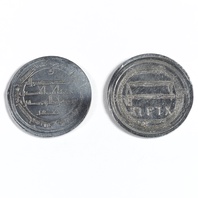
Viking Objects
Reproduction Arabic Silver Dirham
The dirham was a unit of weight used across North Africa, the Middle East, and Persia, with varying values which also referred to the type of coins used in the Middle East during the Viking Age. These coins were extremely prized possessions not only for their silver value but as a way of displaying one’s wealth and vast trade connections. Millions of Arabic Dirhams would have been imported throughout the Viking world and are mostly found in hoards. Arabic coins are especially useful for dating sites, because they carry the date when they were minted. This permits a more accurate dating where the part of the coin with the date survives, whereas European coins can only be dated to the reign of the ruler depicted on them. However, it is also necessary to allow for the time it took the coin to reach the site. In western descriptions of these coins, the Arabic dates found on the coins are usually listed in square brackets, as above, and the European equivalent is listed after it.
Read More
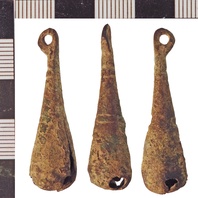
Viking Objects
Harness Bell (NLM-5EFFAE)
This medieval copper-alloy harness bell has changed little from the type that would have been familiar in the Viking Age. They were used alongside other ornaments to decorate harness. This one is made from a sheet of folded metal and still contains the small pea that would have made a noise when the horse moved.
Read More
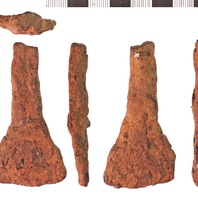
Viking Objects
Chisel (NLM-79460E)
This chisel fragment has a wrought-iron V-shaped blade and likely had a socket for attachment to a handle. Socket attachment using sockets made of rolled metal are characteristic of early medieval metal-working.
Read More
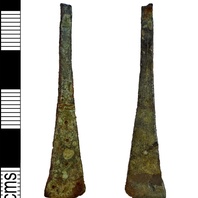
Viking Objects
Copper-Alloy Tweezers (NARC-444DBA)
Tweezers were common personal items that people would have carried with them and could have been highly decorated.
